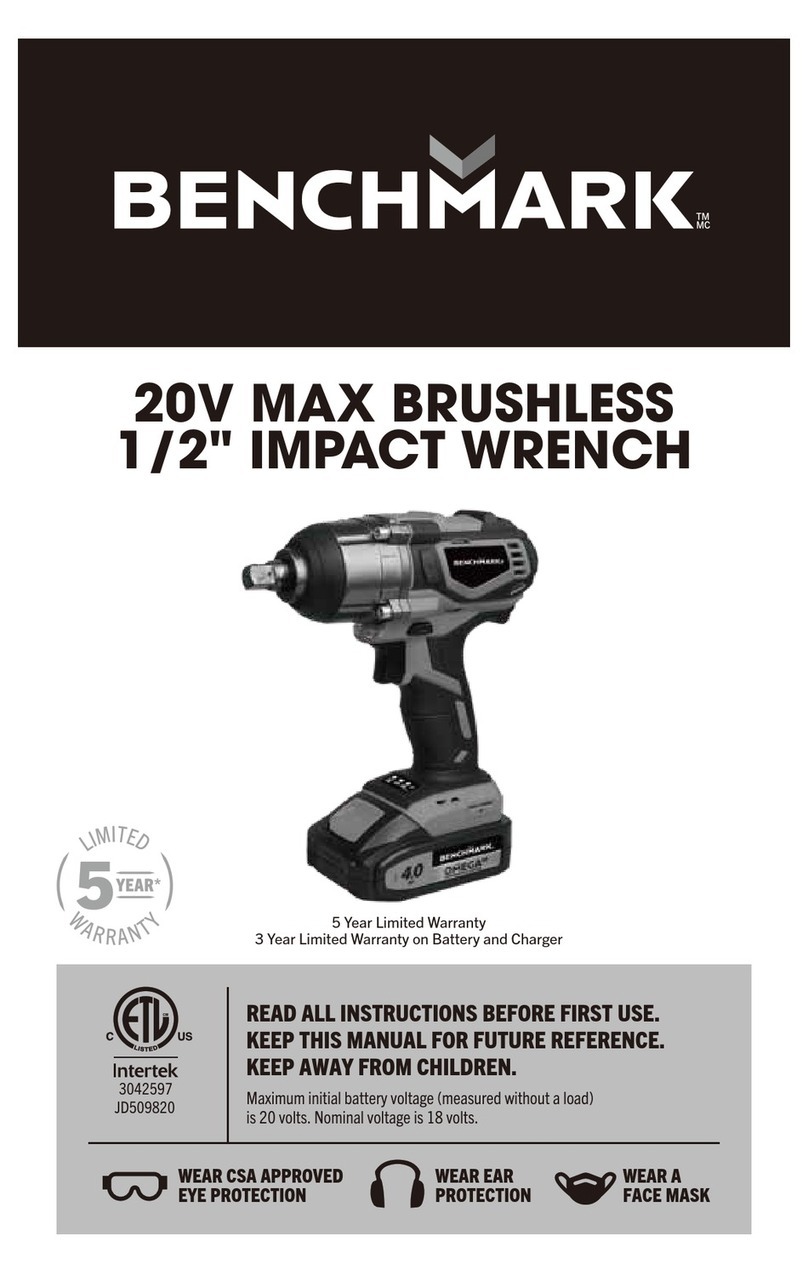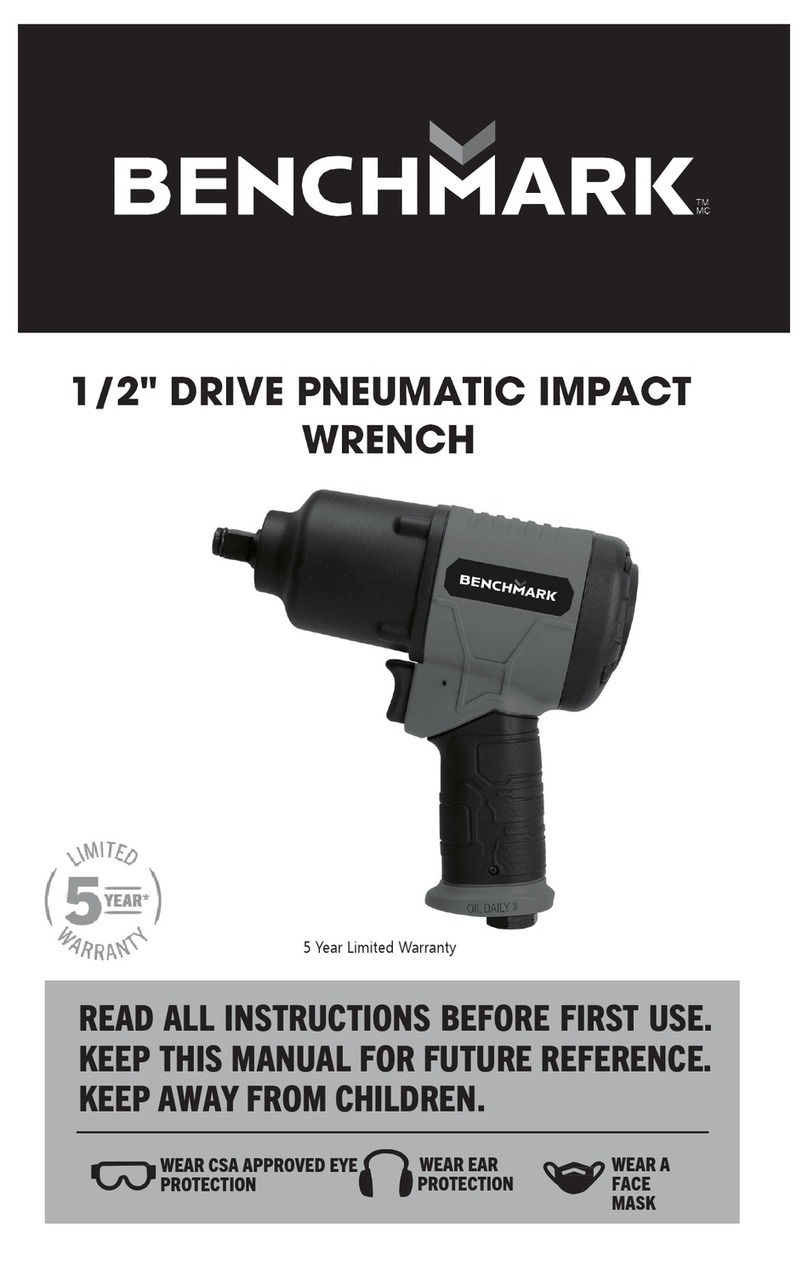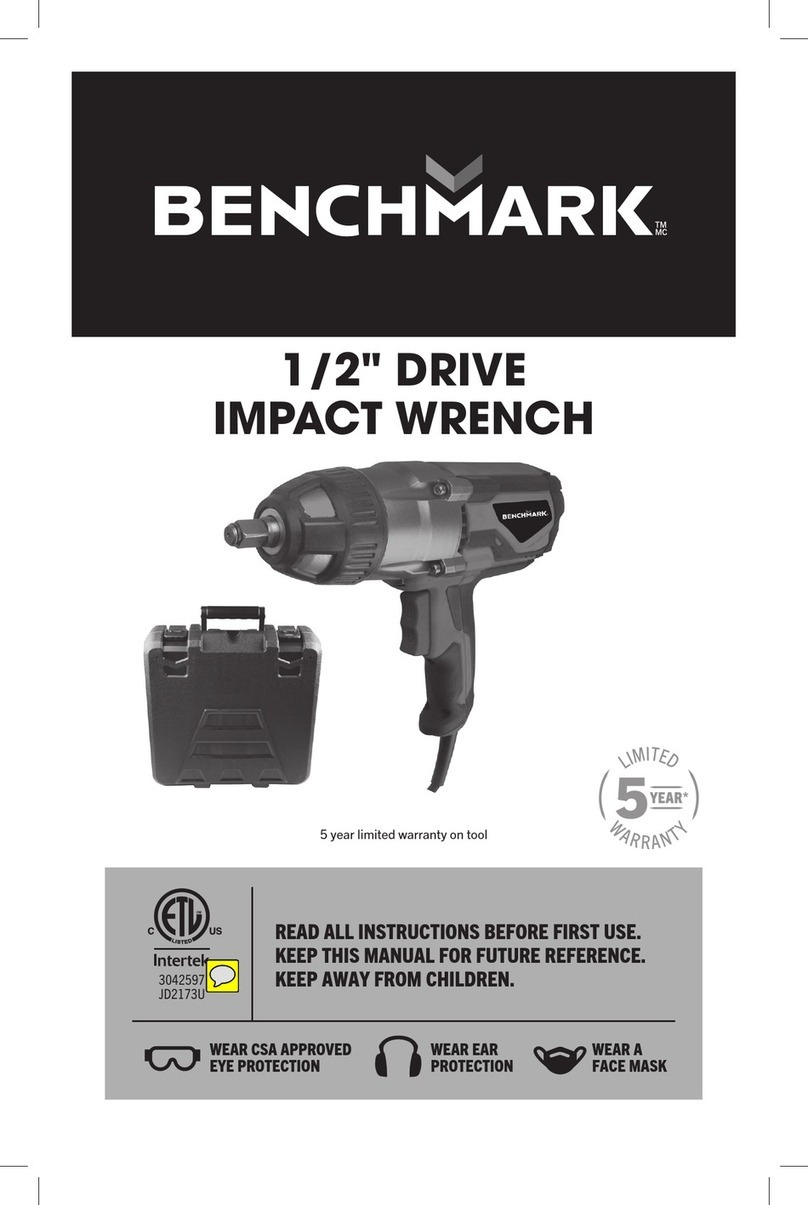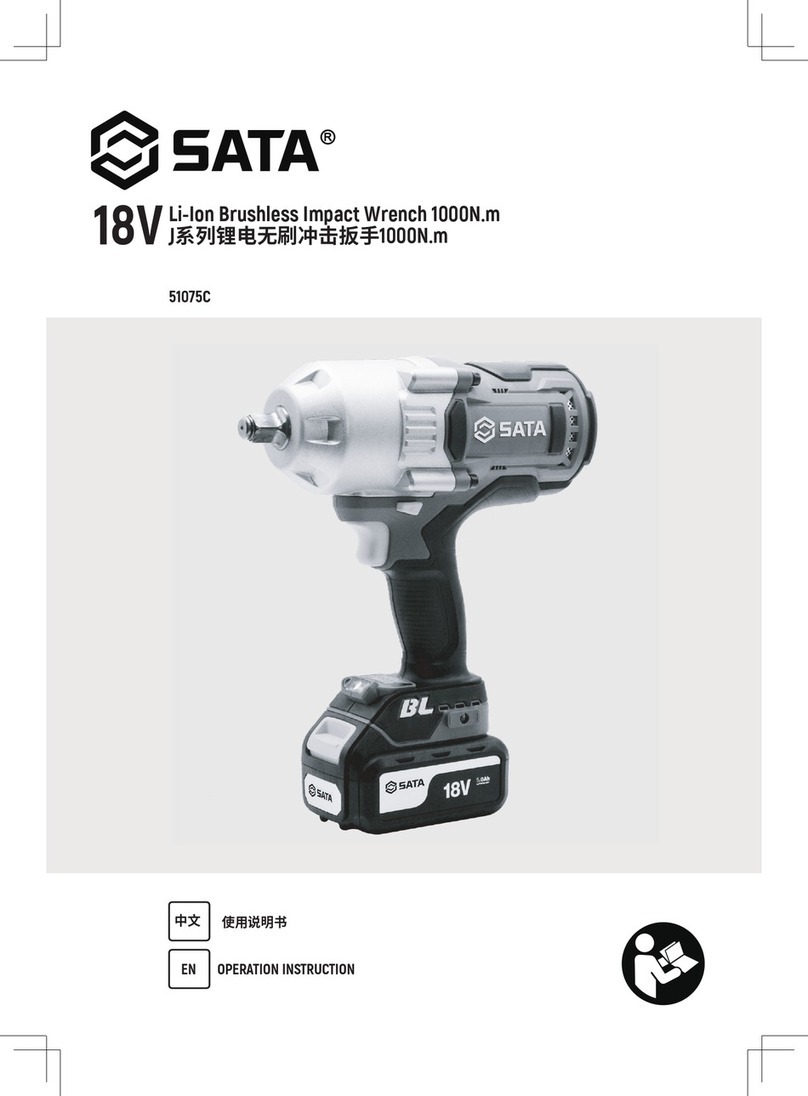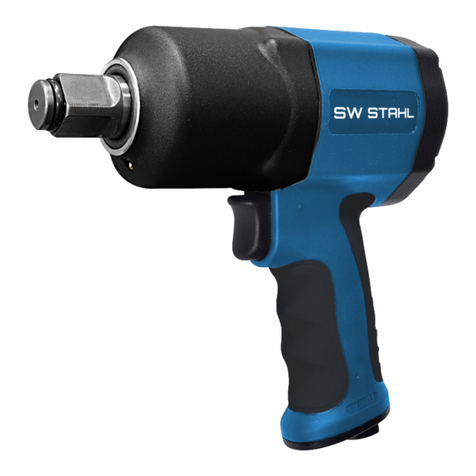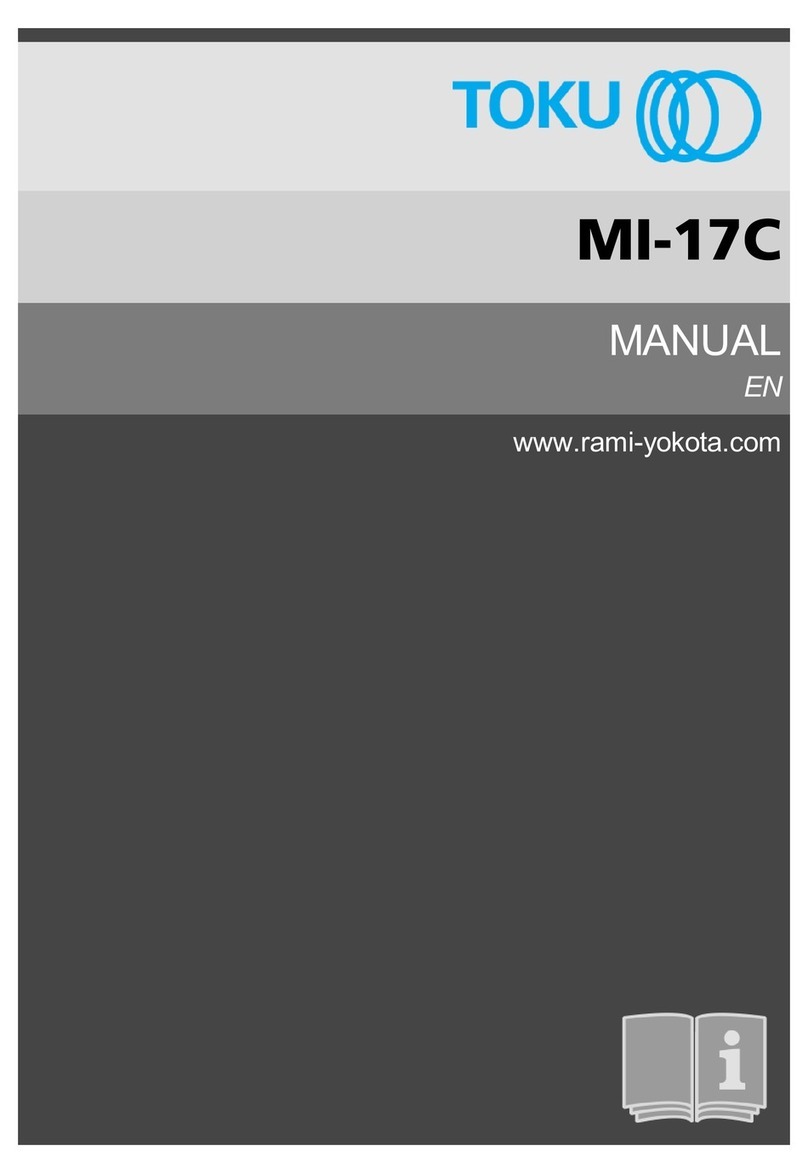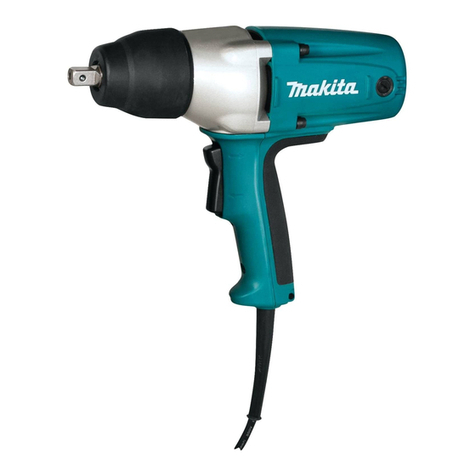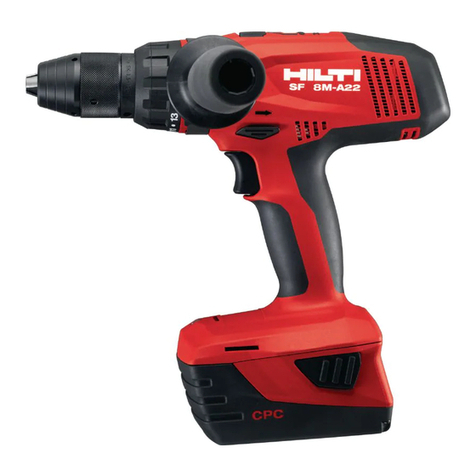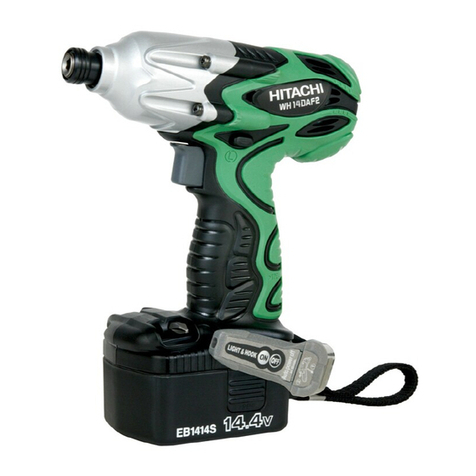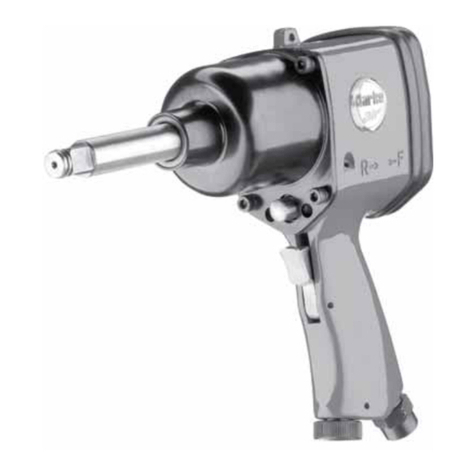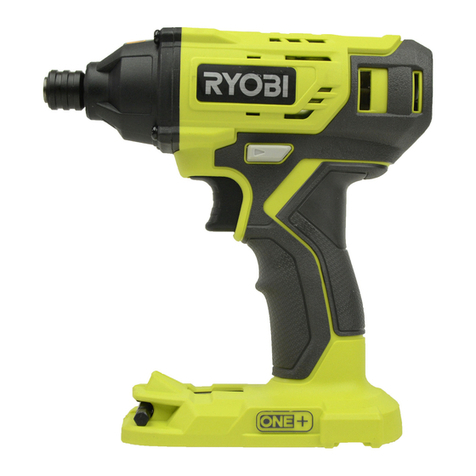Benchmark 1239-300 User manual

20V MAX BRUSHLESS
1/4" IMPACT DRIVER
WEAR CSA APPROVED
EYE PROTECTION
WEAR EAR
PROTECTION
WEAR A
FACE MASK
3042597
JD509620
READ ALL INSTRUCTIONS BEFORE FIRST USE.
KEEP THIS MANUAL FOR FUTURE REFERENCE.
KEEP AWAY FROM CHILDREN.
Maximum initial battery voltage (measured without a load)
is 20 volts. Nominal voltage is 18 volts.
5 Year Limited Warranty
3 Year Limited Warranty on Battery and Charger

1
PRODUCT SPECIFICATIONS
20V MAX BRUSHLESS 2VSR DRILL
2 Variable Speeds 0–2,400 / 0-2600 RPM (no load)
2 Variable Impact Speed 0–2,700/ 0-3,000 BPM
Torque 1,800 in/lbs (158 Nm) maximum
Hex drive Quick release 1/4" (6.35 mm)
Weight 3.5lbs (1.57kg)
Battery 20V 2.5Ah Max* Li-ion (Maximum
charged battery voltage, measured
without load, is 20V with a nominal
value of 18V)
Replacement Battery 5350-023 (2.5Ah)
Replacement Charger Assembly 5350-010 (2.4A) up to 75minutes
charge time
NEED ASSISTANCE?
Call us on our toll-free customer support line:
1-866-349-8665 (Monday through Friday 9am – 5pm Eastern Standard Time)
• Technical questions
• Replacement parts
• Parts missing from package

2
1239-300
TABLE OF CONTENTS
Product Specifications .................................................................................. 1
Table of Contents .......................................................................................... 2
General Safety Instructions ........................................................................... 3
Eye, Ear & Lung Protection ............................................................................ 3
Electrical Safety ............................................................................................ 4
Power Tool Safety .......................................................................................... 4
Work Area Safety .......................................................................................... 4
Electrical Safety ............................................................................................ 4
Personal Safety ............................................................................................. 5
Power Tool Use and Care ............................................................................... 5
Battery Tool Use and Care ............................................................................. 6
Service ......................................................................................................... 6
Specific Safety Rules ..................................................................................... 6
Battery & Charger Safety ............................................................................... 8
Battery Pack Recycling ................................................................................. 9
Symbols ...................................................................................................... 10
Know Your 20V Max Brushless 2 vs Impact Driver ........................................ 11
Assembly and Operation .............................................................................. 12
Checking the Battery Charge Status ............................................................ 12
Checking the Battery Pack .......................................................................... 12
Installing a Battery in the Impact Driver........................................................ 13
Installing Screwdriver Bits and Sockets ....................................................... 14
Forward/Reverse Switch............................................................................... 15
Variable-Speed Trigger Switch...................................................................... 15
Speed And Auto-Stop Control ...................................................................... 16
LED Work Light ........................................................................................... 16
Preparing Screw Holes ................................................................................ 16
Driving Screws ............................................................................................. 17
Installing Nut Drivers For 3/16" To 3/8" Nuts ............................................... 18
Installing Impact Sockets For 7/16" to 3/4" Nuts ......................................... 18
Removing Nuts ........................................................................................... 19
Maintenance ............................................................................................... 20
General ....................................................................................................... 20
Lubrication .................................................................................................. 20
Lithium-ion Battery Performance ................................................................. 20
Lithium-ion Battery Maintenance ................................................................. 20
Battery Pack Removal and Preparation for Recycling.................................... 21
Exploded View ............................................................................................ 22
Parts List .................................................................................................... 23
Warranty ..................................................................................................... 24
20V MAX BRUSHLESS 1/4" IMPACT DRIVER

3
GENERAL SAFETY INSTRUCTIONS
WARNING: Before using this tool or any of its accessories, read this manual
and follow all Safety Rules and Operating Instructions. The important precautions,
safeguards and instructions appearing in this manual are not meant to cover all
possible situations. It must be understood that common sense and caution are
factors which cannot be built into the product.
EYE, EAR & LUNG PROTECTION
SYMBOL MEANING
ALWAYS WEAR EYE PROTECTION THAT CONFORMS WITH CSA Z94.3 or
ANSI SAFETY STANDARD Z87.1
FLYING DEBRIS can cause permanent eye damage.
Prescription eyeglasses ARE NOT a replacement for proper eye protection.
The usage of a safety standard compliant face shield placed over proper
safety glasses or goggles can reduce the risk of facial injury.
Non-compliant eyewear can cause serious injury if broken during the
operation of a power tool.
Use hearing protection, particularly during extended periods of operation
of the tool, or if the operation is noisy.
WEAR A DUST MASK THAT IS DESIGNED TO BE
USED WHEN OPERATING A POWER TOOL IN A
DUSTY ENVIRONMENT.
Dust that is created by power sanding, sawing, grinding, drilling, and other
construction activities may contain chemicals that are known to cause
cancer, birth defects,
or other genetic abnormalities. These chemicals include:
• Lead from lead-based paints
• Crystalline silica from bricks, cement, and other
masonry products
• Arsenic and chromium from chemically treated lumber
The level of risk from exposure to these chemicals varies, according to how
often this type of work is performed. In order to reduce exposure to these
chemicals, work in a
well-ventilated area, and use approved safety equipment, such as a dust mask
that is specifically designed to filter
out microscopic particles.
TO AVOID ELECTRICAL HAZARDS,
FIRE HAZARDS OR DAMAGE TO THE TOOL,
USE PROPER CIRCUIT PROTECTION.
This tool is wired at the factory for 120 V AC operation. It must beconnected
to a 120 V AC, 15 A circuit that is protected by a time-delayedfuse or circuit
breaker. To avoid shock or fire, replace power cordimmediately if it is worn, cut
or damaged in any way.

4
WARNING: Ventilation openings in batteries and chargers must always
be open to allow cooling air to circulate freely. Air vents that are blocked,
restricted or covered may result in the battery or charger overheating.
Overheating may lead to damage to the tool or cause a fire, resulting in
possible serious injury.
POWER TOOL SAFETY
WARNING: Read all safety warnings and instructions. Failure to follow the
warnings and instructions may result in electric shock, fire and/or serious injury.
Save all warnings and instructions for future reference.
WORK AREA SAFETY
Keep work area clean and well lit. Cluttered or dark areas invite accidents.
Do not operate power tools in explosive atmospheres, such as in the presence
of flammable liquids, gases or dust. Power tools create sparks which may ignite
the dust or fumes.
Keep children and bystanders away while operating a power tool. Distractions
can cause you to lose control.
ELECTRICAL SAFETY
Power tool plugs must match the outlet. Never modify the plug in any way.
Do not use any adapter plugs with earthed (grounded) power tools. Unmodified
plugs and matching outlets will reduce risk of electric shock.
Avoid body contact with earthed or grounded surfaces such as pipes, radiators,
ranges and refrigerators. There is an increased risk of electric shock if your body is
earthed or grounded.
Do not expose power tools to rain or wet conditions. Water entering a power tool
will increase the risk of electric shock.
Do not abuse the cord. Never use the cord for carrying, pulling or unplugging
the power tool. Keep cord away from heat, oil, sharp edges or moving parts.
Damaged or entangled cords increase the risk of electric shock.
When operating a power tool outdoors, use an extension cord suitable for
outdoor use. Use of a cord suitable for outdoor use reduces the risk of electric
shock.
If operating a power tool in a damp location is unavoidable, use a residual
current device (RCD) protected supply. Use of a ground fault circuit interrupter
(GFCI) reduces the risk of electric shock.
PERSONAL SAFETY
Stay alert, watch what you are doing and use common sense when operating a
power tool. Do not use a power tool while you are tired or under the influence
of drugs, alcohol or medication. A moment of inattention while operating power
tools may result in serious personal injury.
1239-300
20V MAX BRUSHLESS 1/4" IMPACT DRIVER

5
Use personal protective equipment. Always wear eye protection. Protective
equipment such as dust mask, non-skid safety shoes, hard hat, or hearing
protection used for appropriate conditions will reduce personal injuries.
connecting to power source and/or battery pack, picking up or carrying the
tool. Carrying power tools with your finger on the switch or energizing power tools
that have the switch on invites accidents.
Remove any adjusting key or wrench before turning the power tool on.
A wrench or a key left attached to a rotating part of the power tool may result in
personal injury.
Do not overreach. Keep proper footing and balance at all times. This enables
better control of the power tool in unexpected situations.
Dress properly. Do not wear loose clothing or jewellery. Keep your hair, clothing
and gloves away from moving parts. Loose clothes, jewellery or long hair can be
caught in moving parts.
If devices are provided for the connection of dust extraction and collection
facilities, ensure these are connected and properly used. Use of dust collection
can reduce dust-related hazards.
POWER TOOL USE AND CARE
Do not force the power tool. Use the correct power tool for your application.
The correct power tool will do the job better and safer at the rate for which it was
designed.
Any power
tool that cannot be controlled with the switch is dangerous and must be repaired.
Disconnect the plug from the power source and/or the battery pack from the
power tool before making any adjustments, changing accessories, or storing
power tools. Such preventive safety measures reduce the risk of starting the power
tool accidentally.
Store idle power tools out of the reach of children and do not allow persons
unfamiliar with the power tool or these instructions to operate the power tool.
Power tools are dangerous in the hands of untrained users.
Maintain power tools. Check for misalignment or binding of moving parts,
operation. If damaged, have the power tool repaired before use. Many accidents
are caused by poorly maintained power tools.
Keep cutting tools sharp and clean. Properly maintained cutting tools with sharp
cutting edges are less likely to bind and are easier to control.
Use the power tool, accessories and tool bits etc. in accordance with these
instructions, taking into account the working conditions and the work to be
performed.
result in a hazardous situation.
Hold power tool by insulated gripping surfaces when performing an operation
where the cutting tool may contact hidden wiring or its own cord. Contact with a
“live” wire will make exposed metal parts of the tool “live” and shock the operator.

6
Hold power tool by insulated gripping surfaces, when performing an
operation where the fastener may contact hidden wiring or its own cord.
Fasteners contacting a “live” wire may make exposed metal parts of the power tool
“live” and could give the operator an electric shock.
BATTERY TOOL USE AND CARE
Recharge only with the charger specified by the manufacturer. A charger that
is suitable for one type of battery pack may create a risk of fire when used with
another battery pack.
Use power tools only with specifically designated battery packs. Use of any other
battery packs may create a risk of injury and fire.
When battery pack is not in use, keep it away from metal objects like paper clips,
coins, keys, nails, screws, or other small metal objects that can make a connection
from one terminal to another. Shorting the battery terminals together may cause
burns or fire.
Under abusive conditions, liquids may be ejected from the battery; avoid contact.
If contact accidentally occurs, flush with water. If liquid contacts eyes, additionally
seek medical help. Liquid ejected from the battery may cause irritation or burns.
SERVICE
Have your power tool serviced by a qualified repair person using only identical
replacement parts. This will ensure that the safety of the power tool is maintained.
SPECIFIC SAFETY RULES
WARNING: Know your cordless impact driver. Do not plug in the charger or
install the battery in the tool until you have read and understand this Instruction
Manual. Learn the tool’s applications and limitations, as well as the specific
potential hazards related to this tool. Following this rule will reduce the risk of
electric shock, fire, or serious injury.
Always wear eye protection. Any power tool can throw foreign objects into
your eyes and cause permanent eye damage. ALWAYS wear safety goggles
(not glasses) that comply with ANSI safety standard Z87.1. Everyday glasses
have only impact resistant lenses. They ARE NOT safety glasses.
WARNING: Glasses or goggles not in compliance with ANSI Z87.1 could
cause serious injury when they break.
WARNING: Always use a safety shield, hearing protection and dust mask
when drilling concrete.
WARNING: To avoid fire or toxic reaction, never use gasoline, naphtha,
acetone, lacquer thinner or similar highly volatile solvents to clean the tool.
WARNING: Use only accessories that are recommended for this cordless
drill. Follow the instructions that accompany the accessories. The use of
improper accessories may result in injury to the operator or damage to the tool.
1239-300
20V MAX BRUSHLESS 1/4" IMPACT DRIVER

7
WARNING: If any part is missing or damaged, do not plug the tool into the
power source or install any accessory until the missing or damaged part is replaced.
Use impact sockets and accessories that are designed for use with an impact driver.
Do not use chrome plated sockets and accessories. Chrome plated sockets and
accessories are designed for hand use only and MUST NOT be used with an impact
driver. They may shatter and possibly cause serious injury.
Before each use, check the impact sockets and accessories for excessive wear or
cracks. Worn or damaged sockets or accessories may shatter and possibly cause
serious injury. Worn accessories may allow the socket to come o during operation
of the impact driver.
After installing any accessory in the hex drive, pull outward on the accessory to
ensure it is properly installed and cannot be pulled out of the hex drive.
Never use the impact driver as a torque wrench. Always use a torque wrench to
adjust the fastener to the specified torque.
Keep the impact driver handle and body clean and free of oil and grease. Always
use a clean dry cloth when cleaning. Do not use solvents, brake fluid, gasoline or
other petroleum products to clean the tool. They will damage the tool.
Do not wear neckties or loose clothing.
When wearing gloves, they must be tight fitting and slip resistant type. Leather
gloves o er the best protection.
Always use two hands when operating the impact driver. Use one hand on the
handle and the other on the front of the tool body.
Never place your hand so it is touching the nut driver or accessory when the tool
is turned ON. Your hand could be seriously injured.
Always remove the plug from the power source before installing or removing any
socket or accessory.
Be ready for components to shift when removing any fastener. The speed of the
fastener removal could cause unexpected shifting of the components.

8
BATTERY & CHARGER SAFETY
WARNING: Only use the charger supplied with this kit to charge the 20V
Max* Li-ion batteries for this tool. Charging any other batteries may damage
the charger and possibly cause serious injury.
Do not store or carry the battery in a manner in which metal objects could contact
the exposed metal end. Do not place the battery in aprons, pockets, drawers, etc.
with loose nails, screws, keys etc. The battery could short circuit causing a fire,
personal injury, or damage to the battery.
Never attempt to open the battery for any reason. If the housing of the battery
breaks or cracks, immediately discontinue use and do not recharge.
Do not charge the battery if it is wet or shows any evidence of corrosion.
A small leakage from the battery may occur under extreme usage, charging or
temperature conditions. This does not indicate a failure. However, if the outer
seal is broken and this leakage gets on your skin, follow these steps:
1. Wash immediately with soap and water.
2. Neutralize with a mild acid such as lemon juice or vinegar.
3. If liquid gets into your eyes, flush immediately with clean water for a minimum
of 10 minutes and seek medical attention.
NOTE: The battery liquid is slightly acidic.
Do not incinerate the battery. It can explode in a fire.
Do not use an extension cord. Plug the charger cord directly into an electrical outlet.
Use the charger only in a standard 120V, 60 Hz electrical outlet.
Do not use the charger in wet or damp conditions. It is intended for indoor use only.
Do not use the charger near sinks or tubs. Do not immerse the charger in water. Do
not allow the cord to hang over the edge of a table or counter or touch hot surfaces.
The charger should be placed away from sinks and hot surfaces.
Do not use the charger to charge any batteries other than the cordless drill
batteries. Other batteries may explode.
Do not allow the cord to hang over the edge of a table or counter or touch hot
surfaces. The charger should be placed away from sinks and hot surfaces.
Do not operate charger if the cord or plug is damaged. Replace the damaged cord
and plug immediately.
Do not operate the charger if it has received a sharp blow, been dropped or
otherwise damaged in any way. Have a qualified technician examine the charger
and repair it if necessary. Do not disassemble the charger.
Do NOT charge the batteries when the work area or the battery temperature is at or
below 0° C (32° F) or above 45° C (113° F).
Unplug the charger when not in use and before cleaning or maintenance.
1239-300
20V MAX BRUSHLESS 1/4" IMPACT DRIVER

9
BATTERY PACK RECYCLING
To preserve our natural resources, please recycle or dispose of
batteries properly.
The batteries charged by this charger may contain chemicals
and metals that are harmful to the environment. Never dispose of
re-chargeable batteries in your normal household garbage or in
landfill sites as they will add to the pollution of the environment.

10
SYMBOLS
WARNING: Some of the following symbols may appear on the impact driver
Study these symbols and learn their meaning. Proper interpretation of these
VVOLTS Three-phase alternating current
with neutral
AAmperes Direct current
Hz Hertz noNo load speed
WWatts Alternating or direct current
kW Kilowatts Class II construction
ųF Microfarads Splash-proof construction
LLiters Watertight construction
kg Kilograms Protective grounding at grounding
terminal, Class I tools
HHours .../min Revolutions or reciprocations per
minute
N/cm2Newtons per
square centimeter ØDiameter
Pa Pascals 0
OPM Oscillations per minute Arrow
MIN Minutes Warning symbol
SSeconds Wear your safety glasses
Alternating current Wear a dust mask
Three-phase alternating
current Wear hearing protection
3042597
JD509620
This symbol designates that this tool is listed with Canadian and U.S.
requirements by ETL Testing Laboratories, Inc.
Conforms to UL Std. 60745-1 and 60745-2-11.
Certified to CAN/CSA Std. C22.2 No. 60745-1 and 60745-2-11.
1239-300
20V MAX BRUSHLESS 1/4" IMPACT DRIVER

11
KNOW YOUR 20V MAX BRUSHLESS 2VS
IMPACT DRIVER
Quick
Release
3 LED
Work Light
Forward / Reverse
Switch
Air vents
Trigger
Switch
Speed Selector
Buttons
Battery
5350-023
Belt
Clip
Battery charger
5350-010
Air Vents
Red LED
Green LED

12
ASSEMBLY AND OPERATION
CHECKING THE BATTERY CHARGE STATUS
The level of charge remaining in the battery can be checked by using the battery
LED power indicator that is contained on the end of the battery.
NOTE: The battery charge remaining may be checked while the battery is installed
in the tool with the ON/OFF switch turned OFF. It may also be checked while the
battery is removed from the tool. DO NOT check the battery charge remaining while
the battery is in the charger. You will get a false reading and you may also damage
the battery status system.
1. Press and hold the battery status button located on the end of the battery.
2. One or more of the Four LED lights in the LED window will come ON to indicate
the amount of charge that is remaining in the battery as follows:
Charge Level
Indicator
Amount of Charge
Remaining
0 -
10%
10 -
25%
25 -
50%
50 -
75%
75 -
100%
3. Release the battery status button to turn the LEDs OFF.
CHECKING THE BATTERY PACK
1. Place the battery charger (1) in a dry location near a 110–120V 60 Hz electrical
outlet (Fig. 1).
2. Plug the battery charger into the outlet and make sure the green LED indicator
light (5) comes ON. If it does not, refer to the chart (Fig. 2) to identify the
problem.
3. Turn the battery (2) upside down and slide it onto the charger. NOTE: Make sure
the grooves (3) in the sides of the battery slide over the matching tabs on the
charger (4) until the battery latch “clicks” into place.
FIG. 1
1239-300
20V MAX BRUSHLESS 1/4" IMPACT DRIVER
4 2 3
5 6 1

13
NOTE: a) When the charger is plugged into the wall receptacle and NO battery is on
the charger, the green indicator light (5) will turn ON indicating the charger is “live”.
b) When a discharged battery is installed on the charger, the green indicator light
will turn OFF and the red indicator light (6) will FLASH. The flashing red indicator
light indicates the battery is being charged.
c) If the red indicator light does not come ON, check to make sure battery pack
is slid fully onto the charger and the electrical outlet is working properly.
d) See Fig. 2 at right for other indicator light functions.
e) A discharged battery pack should be fully charged in up to 75 minutes.
f) It is normal for the battery charger to hum and be warm to the touch
during operation.
g) If the battery pack does not charge properly, check to make sure the electrical
outlet is “live”.
h) Do NOT charge batteries when the work area or the battery temperature is at
or below 5°C (41° F) or above 40°C (105° F).
Green Light Red Light Battery Inserted
Into Charger
Charging Status
ON OFF ON Charger connected to power
supply
OFF Flashing YES Battery being charged
ON OFF YES Battery fully charged
OFF ON YES Battery defective or bad contact
ON ON YES Battery too hot or too cold to
be charged
FIG. 2
INSTALLING A BATTERY IN THE IMPACT DRIVER
1. Remove the discharged battery (1) from the drill by pressing downward on the
battery release button (2) and sliding the battery backward until it is removed
from the drill handle (3) (Fig. 3).
2. Slide the fully charged battery onto the matching keys (4) in the drill handle
where the discharged battery has been removed.
NOTE: Make sure the slots in the battery are fully engaged with the mounting keys
in the drill handle. The battery release button will “click” into place when the battery
is fully installed.
WARNING: Do not immerse the battery pack in water. Sudden cooling could
cause a hot battery to explode or leak.

14
FIG. 3
INSTALLING SCREWDRIVER BITS AND SOCKETS
WARNING: Never hold the impact driver with your fingers near the switch while
changing the screwdriver bits. Accidentally touching the switch may start the tool
and possibly cause an injury.
WARNING: Use only screwdriver bits, sockets that are designed for use with an
impact driver. Do not use chrome plated sockets and accessories. Chrome plated
sockets and accessories are designed for hand use only and MUST NOT be used
with an impact driver. They may shatter and possibly cause serious injury.
WARNING: Always remove the battery from the tool before changing any
sockets, bits or accessories. You may injure your hand if the tool is started
accidentally.
1. Pull outward on the quick release chuck (1) (Fig. 4).
2. Insert the grooved end of the impact driver bit holder. (2) into the chuck (3)
of the tool.
NOTES: a) Always use ANSI single ended screwdriver bits or nut driver with the
grooved end. These bits will be properly held in place by the chuck. Other bit types
cannot be properly secured in the chuck. b) Push the screwdriver bit as far as it
will go into the chuck.
3. Release the quick release chuck.
4. Pull outward on the screwdriver bit to ensure it is properly locked into the chuck.
NOTES: a) Use the largest size screwdriver bit that will properly fit the screw
head. b) Make sure the screwdriver bit is in good condition and is neither damaged
nor worn.
1239-300
20V MAX BRUSHLESS 1/4" IMPACT DRIVER
1
2
4 3

15
2 3 1
FIG. 4
FORWARD/REVERSE SWITCH
The forward/reverse switch (1) is conveniently mounted above the trigger switch
(2) (Fig. 5). To make the impact driver rotate clockwise for driving screws, push the
forward/reverse switch to the left. To make the driver rotate counter-clockwise for
removing screws, push the forward/reverse switch to the right
NOTE: a) Never change the position of the forward/ reverse switch while the chuck
is turning. b) The trigger switch will Not function with the forward/reverse switch
in the middle position.
VARIABLE-SPEED TRIGGER SWITCH
This drill is equipped with a variable-speed ON/OFF trigger switch.
1. To start the impact driver, gently squeeze the trigger switch (2) (Fig. 6). NOTE:
The impact driver will turn at its slowest speed when the trigger switch is squeezed
lightly. The impact driver will turn at its fastest speed when the trigger switch is
squeezed firmly.
2. To stop the drill, release the trigger switch.
NOTE: Operating the impact driver at a slow speed for an extended period of time
may cause the impact driver motor or the battery to overheat. If the driver gets hot,
stop operating it and allow it to cool for at least 15 minutes.
1 2 2
FIG. 5 FIG. 6

16
SPEED AND AUTO-STOP CONTROL
(Located on tool foot)
Push the selection button when the tool is in forward for low or high speeds. Push to
select the auto-stop feature when the tool is in reverse.
Speed Direction Lights Application
Low Forward On Low torque and finish work such
as plastic trim or installation
High Forward On Higher torque such as driving
self-tapping screws
Reverse Auto-Stop Reverse On To loosen screws or bolts
LED WORK LIGHT
The LED work light (3) will automatically turn ON when the trigger switch is
squeezed (Fig. 7). It will automatically turn OFF when the trigger switch is released.
NOTE: The LED light has a 20-second time delay.
3
FIG. 7
PREPARING SCREW HOLES
It is important to prepare screw holes before attempting to fasten two pieces
of wood together. Proper preparation will make screws drive easier and prevent
misaligned components, stripped screw heads, splitting and separating of
wood components.
1. Clamp the components that are to be screwed together in their desired
position (Fig. 8).
2. Drill a pilot hole (1) through the outer piece (2) and into the inner piece (3).
Drill hole 2/3 the diameter of the smooth portion of the screw shank.
NOTE: If the wood is soft, drill the hole 2/3 the length of the screw. If the wood
is hard, drill the hole the full length of the screw.
3. Remove the clamp from the two pieces to be screwed together.
4. Enlarge the hole (1) in the outer piece (2) so it is the same size as the smooth
portion of the screw shank (Fig. 9).
1239-300
20V MAX BRUSHLESS 1/4" IMPACT DRIVER

17
5. If using a flat head screw, counter-sink the hole (4) so the head of the screw
will be flush with the surface when fully driven into place.
2 1 3 2 1 4
FIG. 8 FIG. 9
DRIVING SCREWS
When driving screws, care must be taken to use a bit that correctly fits the head of
the screw being driven. Make sure you use the largest bit size that will properly fit
into the head of the screw. The bits must also be in good condition and not worn so
they will drive screws without slipping out of the screw head.
1. Select the correct screwdriver bit for the screw being driven and install it in the
collet (Fig. 4).
2. Set forward/reverse switch to “forward” (Fig. 5).
3. Insert the screwdriver bit fully into the screw head (Fig. 10).
4. While holding the screwdriver bit firmly against the screw and the bit aligned with
the screw, squeeze the trigger switch to start the cordless driver and drive the
screw.
5. When the screw is driven to the correct depth, release the switch and the impact
driver will stop.
NOTE: As the screw is driven into the wood, the torque required to completely drive
the screw into the wood will increase. The impact function will allow you to continue
driving the screw until it is fully nested in the countersunk area.
6. Release the trigger as soon as the screw is driven to the desired depth. Failure
to release the trigger at this point will result in an overdriven screw and possibly
NOTE: To remove screws, follow the same general procedure as for driving screws.
7. Push the forward/reverse button to the RIGHT for removing screws.
8. Insert the bit fully into the screw head.
9. Hold the impact driver and bit firmly against the screw head and squeeze the
trigger switch.
NOTE: The impact action will allow you to remove tight screws.

18
FIG. 10
This impact driver may be used with nut drivers and impact sockets. Although these
accessories are NOT included with this tool, they may be purchased separately.
WARNING: Nut drivers, socket adaptor and sockets MUST be impact rated and
include the ANSI locking groove.
INSTALLING NUT DRIVERS FOR 3/16" TO 3/8" NUTS
1. Select the correct nut driver size.
2. Insert the hex end (1) into the hex drive (2) (Fig. 11).
NOTE: See Fig. 3 for complete procedure.
1 2
FIG. 11
INSTALLING IMPACT SOCKETS FOR 7/16" TO 3/4" NUTS
1. Insert the hex end of the socket adapter (1) into the hex drive (2) (Fig. 12).
2. Select the correct socket size.
3. Push the square end of the socket (3) onto the matching square end of the
adaptor (4).
NOTE: Make sure the socket is fully installed onto the square portion of the adapter.
1239-300
20V MAX BRUSHLESS 1/4" IMPACT DRIVER

19
REMOVING NUTS
1. Press the forward/reverse button to the RIGHT for removing nuts (Fig. 5).
2. Place the socket fully onto the nut.
3. Hold the nut driver socket and impact driver firmly against the nut with both
hands. With the nut driver aligned with the nut, squeeze the trigger switch to start
the impact driver and remove the nut.
NOTE: When removing fasteners, do not allow the impact driver to operate more
than 5 seconds unless the fastener begins to turn. If the fastener fails to turn within
5 seconds, reverse the direction of rotation and operate the impact driver in a
forward direction on the fastener for a few seconds. Now switch back to reverse
direction and remove the fastener. This procedure will usually break loose seized
or “frozen” fasteners.
WARNING: Operating the impact driver for more than 5 seconds at a time on
a seized or “frozen” fastener will place severe stress on the impact driver and cause
damage. It may also break the fastener.
3 4 1 2
FIG. 12
Table of contents
Other Benchmark Impact Driver manuals
Popular Impact Driver manuals by other brands

Cornwell Tools
Cornwell Tools CAT2125 operating instructions
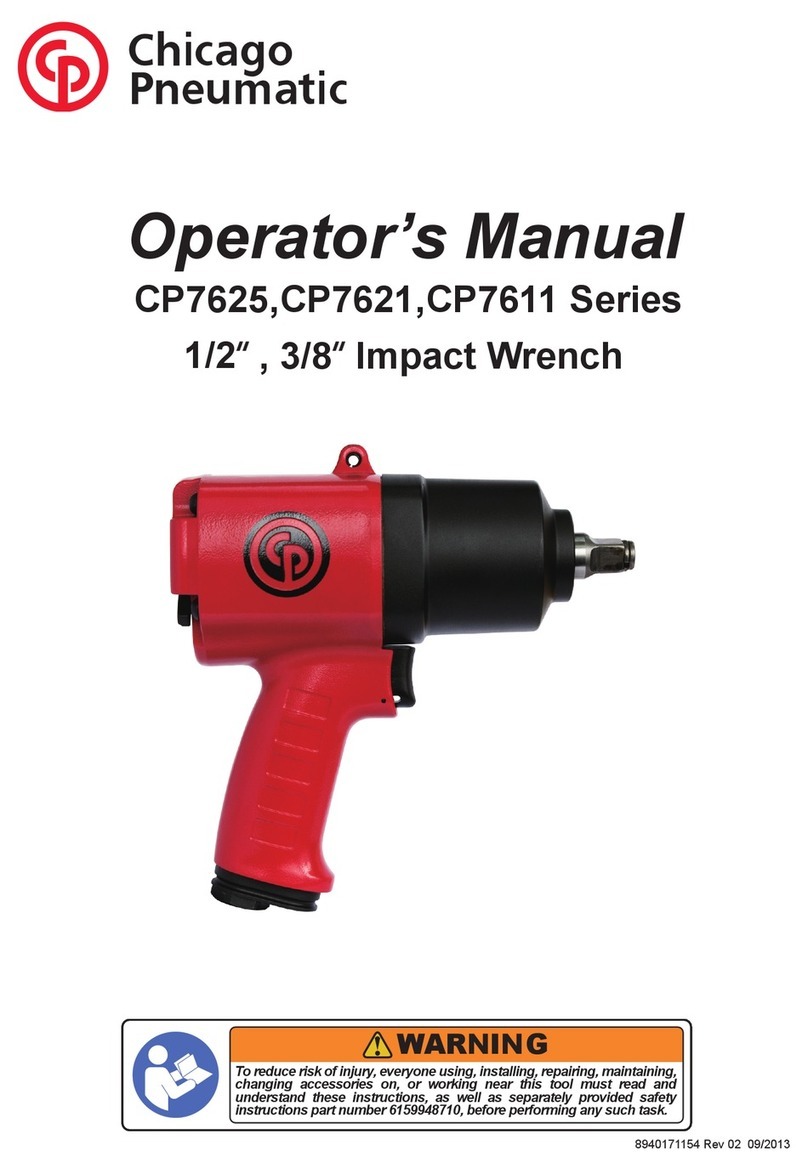
Chicago Pneumatic
Chicago Pneumatic CP7625 Series Operator's manual

GRAPHITE PRO
GRAPHITE PRO 59GP402 instruction manual

Makita
Makita 6980FD instruction manual
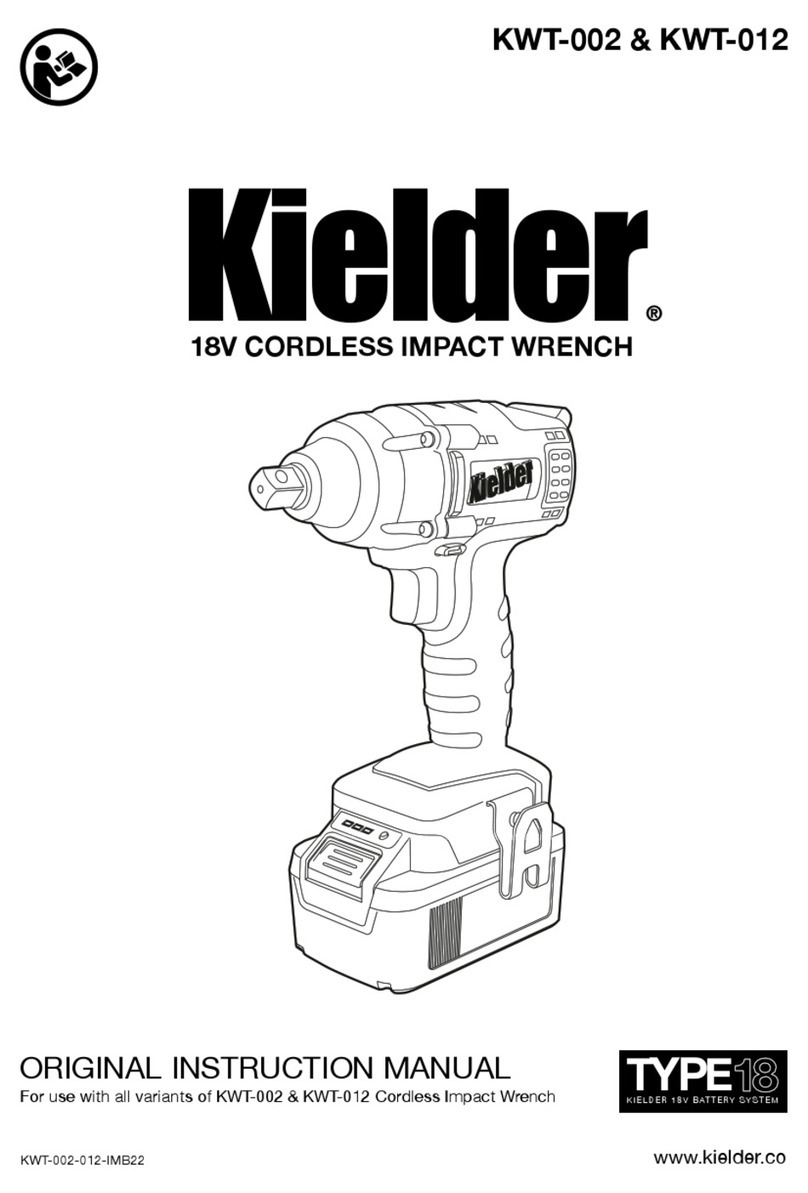
Kielder
Kielder KWT-002 Original instruction manual
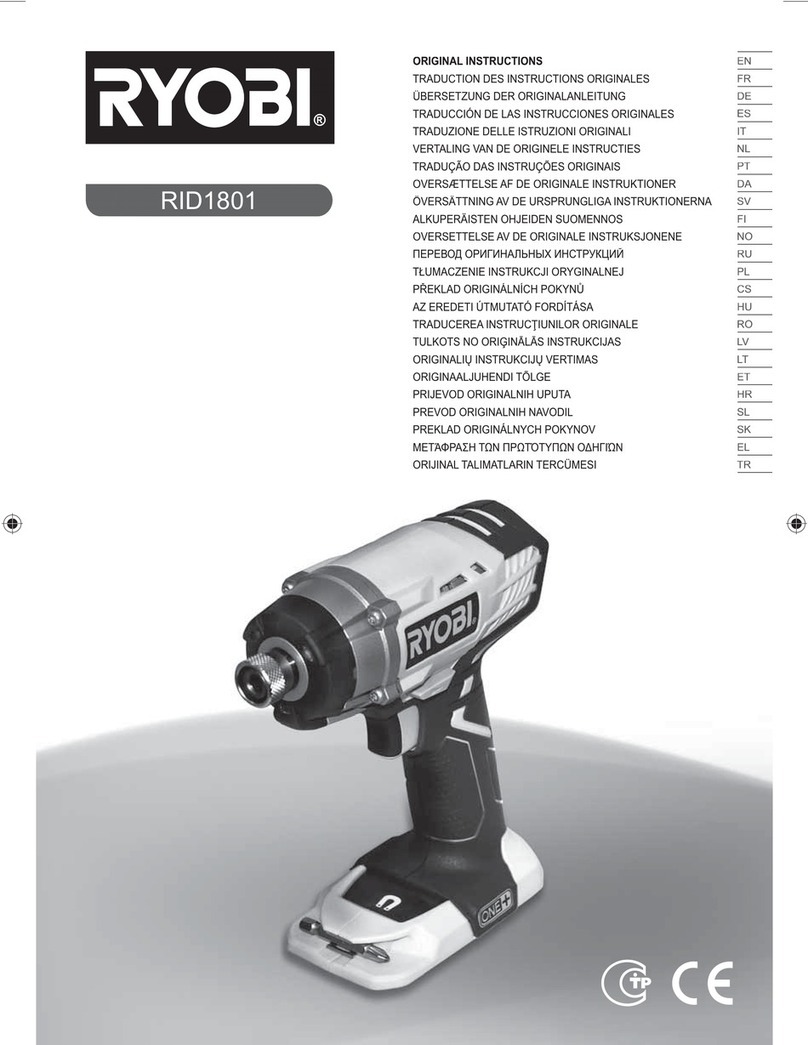
Ryobi
Ryobi RID1801 Original instructions
